【精品报告】毕马威-智慧城市:未来香港2030(英文)
国际商务英语写作模板商业计划书

国际商务英语写作模板:商业计划书篇一:商业计划书模板---英文版精编资料商业计划书模板---英文版BUSINESS PLAN TEMPLATEBUSINESS PLAN[My Company]123 Main StreetAnytown, USA 10000123-4567[Your Name][DATE]TABLE OF CONTENTS...商业计划书商业计划书模板---英文版BUSINESS PLAN TEMPLATEBUSINESS PLAN[My Company]123 Main StreetAnytown, USA 10000123-45671[Your Name][DATE]2TABLE OF CONTENTSExecutive Summary ....................................................................................... (1)Management ................................................................................ (2)[Company] History ............................................................................................ . (5)[Product/Service] Description ................................................................................... .. (7)Objectives....................................................................................... . (9)Competitors ................................................................................. .. (10)Competitive Advantages ................................................................................... . (11)Innovation ..................................................................................... . (13)Pricing ............................................................................................ .. (14)Specific Markets .......................................................................................... . (15)Growth Strategy .......................................................................................... . (16)Market Size and Share ............................................................................................... . (17)Targeting New Markets .......................................................................................... .. (18)Location ......................................................................................... (19)Manufacturing Plan .................................................................................................. (20)Research &Development ............................................................................... (21)Historical Financial Data ................................................................................................. .. (22)Proforma Financial Data ................................................................................................. .. (23)Proforma Balance Sheet ............................................................................................... . (26)Cost Control ........................................................................................... (27)Effects of Loan or Investment .................................................................................... . (28)Attachments ................................................................................. . (29)3Executive Summary [My Company] was formed asa [proprietorship, partnership, corporation] in [Month, Year] in [City, State], by [John Doe] in response to the following market conditions:[Startup, growth] opportunities exist in [Product/Service].The need for use of efficient distribution (转载于: 小龙文档网:国际商务英语写作模板:商业计划书)and financial methods in these overlooked markets.[I/We] have several customers who are willing to place large [orders,contracts] within the next three months.Several other prospective [customers/clients] have expressed serious interest in doing business within six months. [I/We] previously owned a company that was active in the widget markets. Over the past few years I spent much time studying ways to improve overall performance and increase profits. This plan is a result of that study. The basic components of this plan are:1. Competitive pricing2. Expand the markets3. Increased advertising4. Lower our unit costs,5. Thereby achieving higher profits.1. Sign contracts2. Increased advertising3. Increase office staffTo this end, [I/we] need investment from private individuals and/or companies. A total of $XXX is being raised which will be used to finance working capital, plant and equipment. The company will be incorporated and common stock issued to investors. The company will be run as a [proprietorship, partnership, corporation].Financial Goals Sales Net Income Earnings pershareYear 1 $25,000 .01 Year 2 $250,000 .12 Year 3 $375,000 .141Management[Name] [Title]??[Experience]??Sales growth from zero to $1,000,000 in five years.??Led market in market share - 30%.Formulated advertising budgets & campaigns.Pioneered new distribution channels. Established national sales force.Established national repair & service centers.Brought new and innovative products to the market.Designed point-of-purchase materials.[Education}University of BostonBoston, MA- Computer SciencesPresidentJohn Q. Doe, Chief Executive Officer, and Director since February 1988 and President since January 1990. Mr. Doe was the founder and Chief Executive Officer of the original operating company known as Random Excess, Inc. He has had experience in the widget field with his own firm, John Doe Co., of Oshkosh (Wisconsin), from 1980 to 1987. This firm was sold to FatCat Widgets, Inc. in 1987.篇二:商务英语写作(商业计划书写作格式)商务英语写作:商业计划书写作格式XX-03-24 13:39:08 来源:爱词霸资讯官网封面(Title page)企业的名称和地址Name and address of business负责人的姓名和地址Name(s) and address(es) of principals企业的性质Nature of business报告机密性的陈述Statement of confidentiality目录(Table of contents)1. 概述/总结(Executive summary)2. 行业及市场分析(Industry analysis)对未来的展望和发展趋势(Future outlook and trends)竞争者分析(Analysis of competitors)市场划分(Market segmentation)行业预测(Industry forecasts)3. 企业的描述(The description of the venture)企业的宗旨和目标(Mission statement and objectives)产品或服务的描述(Description of the product or service)企业的规模(Size of business)产品的进一步开发(Future potential/product development)竞争优势(Competitive advantage)办公设备和人员(Office equipment and personnel)创业者的背景(Backgrounds of entrepreneurs)4. 生产计划(Production plan)制造进程/被分包的数量(Manufacturing process / amount subcontracted)选址(Location)厂房(Physical plant)机械和设备(Machinery and equipment)原材料的供给情况(Sources of raw materials to be supplied)生产能力和提高的可能性(Output limitations,if any,and scale-up possibilities)质量控制计划(Quality control plans)5. 营销计划(The marketing plan)定价(Pricing)分销(Distribution)促销(Promotion)产品预测(Product forecasts)预见的涨价(Anticipated mark-up)竞争对手的反映(Competitors’response)市场份额预测(Market share projection)控制(Controls)6. 组织计划(Organizational plan)所有权的形式(Form of ownership)合作者或主要股权所有人的身份(Identification of partners or principal shareholders)负责人的权利(Authority of principals)管理层成员的背景(Management team background)组织成员的角色和责任(Roles and responsibilities of members of organization)7. 风险与对策分析(Assessment of risks)企业弱点的评价(Evaluate weakness if business)新技术(New technologies)应急计划(Contingency plan)8. 财务计划(Financial plan)各类业绩比率和投资回报(Summary of performance ratios, ROI etc.)销售预测(Sales forecasts)财务预测的假设(Assumptions underpinning financial forecasts)损益表(Income statement / Profit and lossstatement)预测现金流量表(Cash flow projections)资产欠债预估表(Pro forma balance sheet)量本利分析(Break-even analysis)资金来源和运用(Sources and applications of funds)9. 融资需求(Financing requirements)融资前的活动小结(Summary of operations prior to financing)此刻的股东和未付债款(Current shareholders, loans outstanding)资金需要量及时间(Funds required and timing)投资回报(The deal on offer)资本欠债比率和盈利与利息比率(Anticipated gearing and interest cover)投资者退出方式(Exit routes for investors)附录(Appendix)1. 管理人员简历(Management team biographies)2. 职业咨询人员背景(Names and details of professional advisors)3. 技术参数和图纸(Technical data and drawings)4. 专利、版权、设计等(Details of patents,copyright, designs)5. 审计的报表(Audited accounts)6. 信件(Letters)7. 市场调研数据(Market research data)8. 租约或合同(Leaser or contracts)9. 供给商的报价单(Price lists from suppliers)10. 客户的定单(Orders from customers)篇三:英文商业计划书模板英语商业计划书(Business Plan)第一讲:概述第二讲:现状分析第三讲:目标肯定第四讲:组织结构第五讲:产品分析第六讲:市场分析第七讲:市场策略第八讲:生产分析第九讲:财务分析第十讲:附件第一讲:概述(executive summary)概述是整个商业计划的第一部份,相当于整个商业计划的浓缩,使整个商业计划的精华所在。
英语作文-大数据分析助力智慧城市交通规划
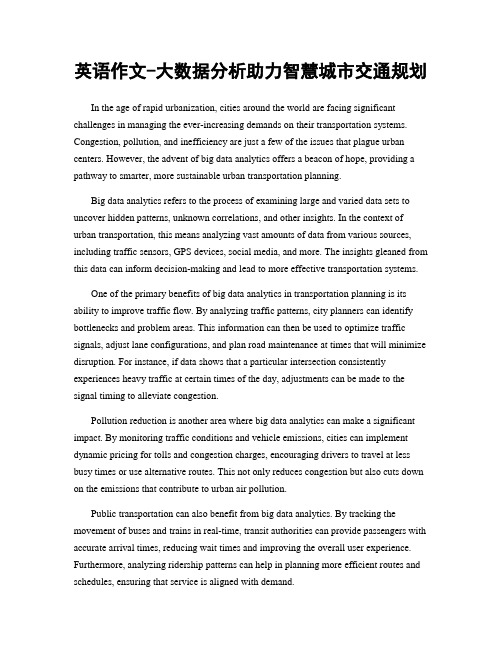
英语作文-大数据分析助力智慧城市交通规划In the age of rapid urbanization, cities around the world are facing significant challenges in managing the ever-increasing demands on their transportation systems. Congestion, pollution, and inefficiency are just a few of the issues that plague urban centers. However, the advent of big data analytics offers a beacon of hope, providing a pathway to smarter, more sustainable urban transportation planning.Big data analytics refers to the process of examining large and varied data sets to uncover hidden patterns, unknown correlations, and other insights. In the context of urban transportation, this means analyzing vast amounts of data from various sources, including traffic sensors, GPS devices, social media, and more. The insights gleaned from this data can inform decision-making and lead to more effective transportation systems.One of the primary benefits of big data analytics in transportation planning is its ability to improve traffic flow. By analyzing traffic patterns, city planners can identify bottlenecks and problem areas. This information can then be used to optimize traffic signals, adjust lane configurations, and plan road maintenance at times that will minimize disruption. For instance, if data shows that a particular intersection consistently experiences heavy traffic at certain times of the day, adjustments can be made to the signal timing to alleviate congestion.Pollution reduction is another area where big data analytics can make a significant impact. By monitoring traffic conditions and vehicle emissions, cities can implement dynamic pricing for tolls and congestion charges, encouraging drivers to travel at less busy times or use alternative routes. This not only reduces congestion but also cuts down on the emissions that contribute to urban air pollution.Public transportation can also benefit from big data analytics. By tracking the movement of buses and trains in real-time, transit authorities can provide passengers with accurate arrival times, reducing wait times and improving the overall user experience. Furthermore, analyzing ridership patterns can help in planning more efficient routes and schedules, ensuring that service is aligned with demand.Safety is a critical concern in urban transportation, and big data analytics can play a vital role in enhancing it. By examining accident reports and traffic data, cities can identify hazardous road conditions or dangerous intersections and take proactive measures to improve safety. This could involve redesigning intersections, improving road surfaces, or increasing the visibility of traffic signs.The integration of big data analytics into urban transportation planning also paves the way for the development of smart cities. In a smart city, data-driven decision-making leads to a more responsive and adaptive urban environment. For example, streetlights equipped with sensors can adjust brightness based on pedestrian and vehicle traffic, conserving energy when full illumination is not needed.In conclusion, big data analytics is revolutionizing the way cities approach transportation planning. By harnessing the power of data, urban centers can create transportation systems that are not only more efficient and safer but also more sustainable. As technology continues to advance, the potential for further improvements is vast, promising a future where urban transportation is a seamless, integrated experience that meets the needs of all city dwellers. The journey towards smarter cities is well underway, and big data analytics is the vehicle driving this transformation. With careful planning and innovative thinking, the road ahead looks promising for urban transportation. 。
大数据标准化白皮书
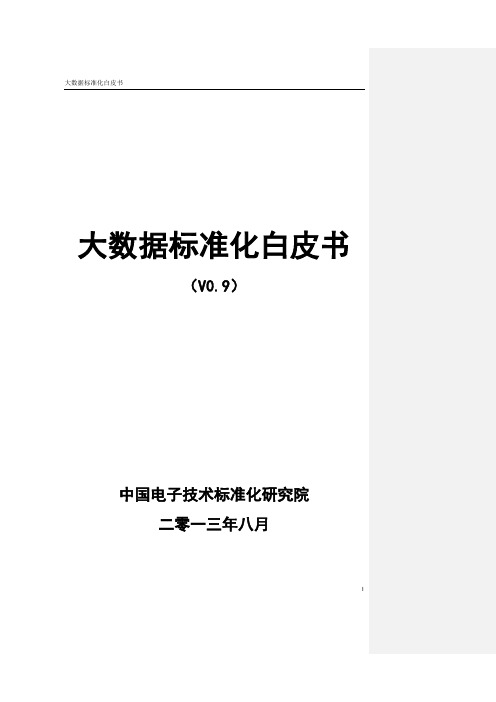
关于智慧化城市的英语作文
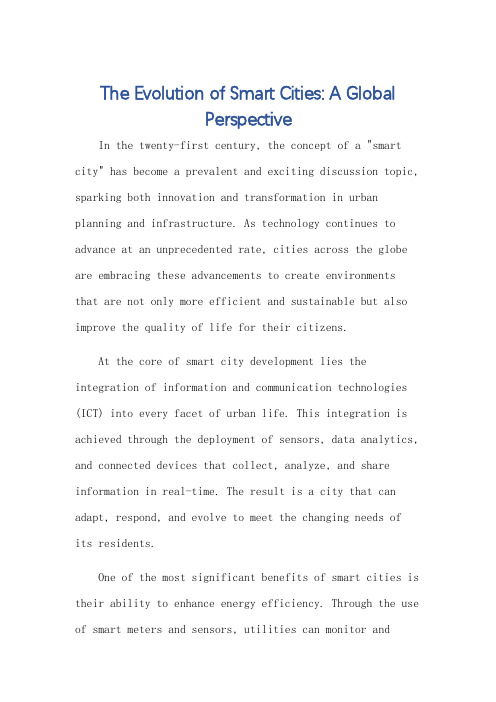
The Evolution of Smart Cities: A GlobalPerspectiveIn the twenty-first century, the concept of a "smart city" has become a prevalent and exciting discussion topic, sparking both innovation and transformation in urban planning and infrastructure. As technology continues to advance at an unprecedented rate, cities across the globe are embracing these advancements to create environmentsthat are not only more efficient and sustainable but also improve the quality of life for their citizens.At the core of smart city development lies the integration of information and communication technologies (ICT) into every facet of urban life. This integration is achieved through the deployment of sensors, data analytics, and connected devices that collect, analyze, and share information in real-time. The result is a city that can adapt, respond, and evolve to meet the changing needs ofits residents.One of the most significant benefits of smart cities is their ability to enhance energy efficiency. Through the use of smart meters and sensors, utilities can monitor andmanage energy use more effectively, reducing waste and costs while promoting sustainability. Additionally, smart grid systems can predict and balance supply and demand, preventing power outages and ensuring a reliable energy supply.In terms of transportation, smart cities are revolutionizing the way people get around. With the help of GPS technology, real-time data, and connected vehicles, traffic flow can be optimized, reducing congestion and improving travel times. Autonomous vehicles and ride-sharing services are also becoming increasingly common, further revolutionizing the transportation landscape.Smart cities are also improving public safety through the use of advanced surveillance systems, emergency response systems, and predictive analytics. These technologies help authorities to identify and respond to threats more quickly and effectively, keeping citizens safe and secure.Moreover, smart cities are fostering economic growth by creating a more favorable environment for businesses and innovation. By providing access to data and resources,smart cities are enabling companies to be more competitive and innovative, driving economic prosperity and job creation.However, while the benefits of smart cities are numerous, their implementation also poses challenges. The integration of technology requires significant investment in infrastructure and human capital. Additionally, issues of data privacy and security must be addressed to ensure that personal information is protected.Despite these challenges, the future of smart cities looks bright. As technology continues to advance and become more accessible, we can expect to see even more cities embrace smart technology, creating environments that are safer, more efficient, and more sustainable.**智慧城市的演变:全球视角**在二十一世纪,智慧城市的概念已成为一个普遍且令人兴奋的话题,引发了城市规划和基础设施方面的创新和变革。
2050愿景
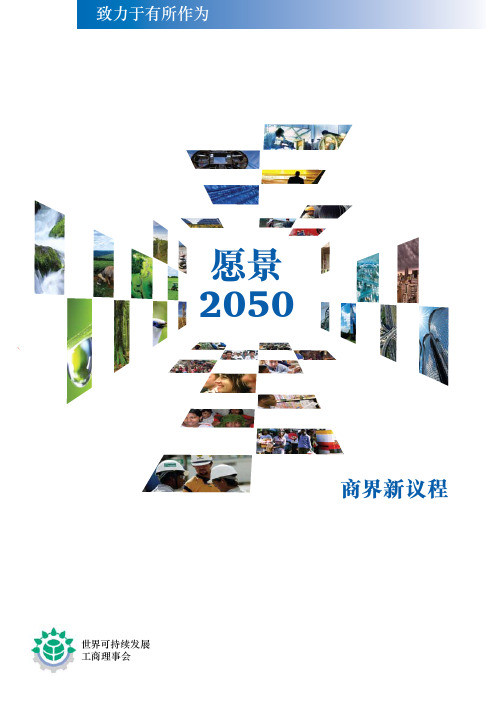
免责声明 这份报 告以世界可持 续 发 展 工商 理事会的名义发布,是理事会29个 成员公司代表为期18个月的合作 成果,并得到了理事会秘书处的支 持。像 理事 会其他 项目一样,《 愿 景 2 0 5 0》吸引了全 世界广大 利 益 相关方的参与。理事会与项目成员 以 及一 些 其 他 顾 问 开展了密 切 的 协商,编制了本报告。报告得到了 所有项目成员的审查,确保就主要 观点和意见达成一致意见。然而, 这并不意 味 着 每 一 个成 员都 赞 同 或同意报告中的每一个声明。读者 应自行决 定 是 否 使 用或 将本 报告 视作可靠资料。
版权所有©世界可持续发展工商 理事会,2010年2月,ISBN: 9783-940388-57-5
设计:Services Concept 照片来源: iStock、Flickr、、联合 国人口活动基金会、Dreamstime, Stora Enso, Titan, Arcelor Mittal、壳牌、世界银行
先正达国际首席执行官
Idar Kreutzer Storebrand集团执行官
Mohammad A. Zaidi博士 美国铝业执行副总裁兼首席技术官
《愿景2050》商界新议程
报告摘要
2050年,在地球的承载范 目前最适合指导行动的启明星。这 • 在不增加使用土地和水资源的
围内,全世界约90亿人口 颗启明星意在帮助各国政府、企业
推 广最佳做 法 ——展 示企 业 对可 持续发展的贡献,并在成员中间共 享最佳做法
开展 全 球外联 活 动 ——帮助发 展 中国家和经济转型国家实现可持 续发展的未来
《愿景2050》联系人 项目总监: Per Sandberg,sandberg@ 项目助理经理: Kija Kummer,kummer@ 项目经理: Nijma Khan,nijma.khan@ 项目经理: Li Li Leong,li.li.leong@
2018智能投顾白皮书

智能投顾,是IT科技和金融领域相结合的前沿应用领域。
它能够基于对投资者的精准画像,通过将现代金融理论融入人工智能算法,从而为投资者提供基于多元化资产的个性化、智能化、自动化和高速化的投资服务。
自2008年金融危机后,美国首家智能投顾公司Betterment于当年成立,随后Wealthfront,Personal Capital,Future Advisor,Motif Investing等创新型公司相继成立。
目前, 先锋集团(VanguardGroup)推出了VPAS,嘉信理财推出了SIP,富达基金推出了Fidelity Go,美林证券推出了Merrill Edge,摩根士丹利推出了Access Investing,“华尔街之狼- Kensho”推出了Warren。
智能投顾作为金融科技(FinTech)应用的最前沿领域,正席卷美国传统金融界。
发源于美国的智能投顾科技理论和技术西行东渐,我国智能投顾于2015年开始起步,虽然起步较晚,但是发展迅速。
招商银行推出了“摩羯智投”,工商银行推出了“AI投”,中国银行推出了“中银慧投”,平安银行推出了“平安智投”,兴业银行推出了“兴业智投”,广发证券推出了“贝塔牛”,平安证券推出了“AI慧炒股”,长江证券推出了“阿凡达”,京东集团推出了“京东智投”,羽时金融推出了“AI股”和“AI投顾”。
代表IT最新最前沿的人工智能技术在融入了金融行业后,有力地推进了传统金融行业的变革,有力地践行了普惠金融的理念。
虽然国内智能投顾的发展势头兴旺,但是商业模式不清晰,行业内鱼龙混杂,很多打着智能投顾概念的传统公司混杂其中,让人难以明辨。
什么是智能投顾?智能投顾的国内外发展现状如何?国内智能投顾业务的发展面临哪些问题和挑战?作为新生事物,智能投顾的IT技术路线,智能投顾的商业模式,智能投顾的风险控制,智能投顾业务的国内外监管政策比较,如何界定智能投顾公司的业务边界,采用哪些方向的标准评价智能投顾公司,智能投顾未来的发展趋势,针对这些大家关心的焦点问题,《2018智能投顾行业白皮书》希望能为大家作出一些抛砖引玉的探讨。
建造智慧城市的建议 英语作文
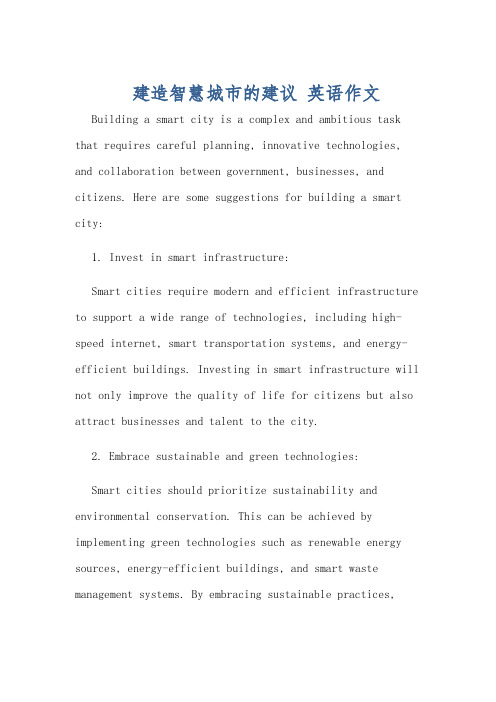
建造智慧城市的建议英语作文Building a smart city is a complex and ambitious task that requires careful planning, innovative technologies, and collaboration between government, businesses, and citizens. Here are some suggestions for building a smart city:1. Invest in smart infrastructure:Smart cities require modern and efficient infrastructure to support a wide range of technologies, including high-speed internet, smart transportation systems, and energy-efficient buildings. Investing in smart infrastructure will not only improve the quality of life for citizens but also attract businesses and talent to the city.2. Embrace sustainable and green technologies:Smart cities should prioritize sustainability and environmental conservation. This can be achieved by implementing green technologies such as renewable energy sources, energy-efficient buildings, and smart waste management systems. By embracing sustainable practices,cities can reduce their carbon footprint and create a healthier environment for their citizens.3. Foster innovation and entrepreneurship:Smart cities should create an environment that encourages innovation and entrepreneurship. This can be done by establishing innovation hubs, providing support for startups, and fostering collaboration between businesses, government, and academic institutions. By nurturing a culture of innovation, cities can attract talent and investment, driving economic growth and creating new opportunities for their citizens.4. Improve connectivity and accessibility:Connectivity is essential for a smart city, as it enables citizens to access information and services easily. Cities should invest in high-speed internet infrastructure, public Wi-Fi hotspots, and smart transportation systems to improve connectivity and accessibility for all citizens, regardless of their location or socioeconomic status.5. Enhance public safety and security:Smart cities should leverage technology to enhancepublic safety and security. This can be achieved throughthe deployment of smart surveillance systems, emergency response technologies, and data-driven crime prevention strategies. By prioritizing public safety, cities cancreate a secure and peaceful environment for their citizens.6. Empower citizens through digital engagement:Citizen engagement is crucial for the success of a smart city. Cities should leverage digital technologies to empower citizens to participate in decision-making processes, access public services, and provide feedback to the government. By fostering digital engagement, cities can create a more inclusive and transparent governance system.7. Ensure data privacy and security:As smart cities collect and analyze large amounts of data, it's essential to prioritize data privacy and security. Cities should implement robust data protection measures, educate citizens about their rights, andestablish clear guidelines for the ethical use of data. By safeguarding data privacy and security, cities can buildtrust with their citizens and ensure the responsible use of technology.8. Collaborate with other cities and stakeholders:Building a smart city requires collaboration with other cities, stakeholders, and industry partners. Cities should exchange best practices, share resources, and collaborateon common challenges such as transportation, energy, and public services. By working together, cities can leverage collective expertise and resources to accelerate theirsmart city initiatives.以上是我对建造智慧城市的一些建议,希望能够对您有所帮助。
语言服务助力粤港澳大湾区建设

语言服务助力粤港澳大湾区建设目录一、内容概要 (2)(一)粤港澳大湾区概述 (2)(二)语言服务的重要性 (3)二、粤港澳大湾区语言服务现状 (4)(一)语言服务体系建设 (5)(二)语言服务产业发展 (6)(三)语言技术应用现状 (8)三、语言服务在粤港澳大湾区建设中的作用 (9)(一)促进人文交流 (10)(二)推动经济发展 (12)(三)提升城市竞争力 (13)四、粤港澳大湾区语言服务挑战与对策 (14)(一)面临的挑战 (16)1. 语言多样性带来的挑战 (16)2. 语言服务人才短缺问题 (17)3. 技术应用与创新的不足 (18)(二)应对策略 (19)1. 加强语言服务政策规划 (20)2. 加大语言服务人才培养力度 (22)3. 推动语言技术创新与应用 (23)五、语言服务与粤港澳大湾区的未来发展 (24)(一)语言服务与港澳融入国家战略 (26)(二)语言服务与湾区城市建设合作 (27)(三)语言服务与湾区文化交流互鉴 (28)六、结语 (29)(一)总结 (29)(二)展望未来发展趋势 (30)一、内容概要随着粤港澳大湾区建设的深入推进,语言服务在促进区域内的交流与合作、提高人才素质、推动科技创新等方面发挥着越来越重要的作用。
本文档旨在分析语言服务在大湾区建设中的关键作用,探讨如何提升语言服务质量和水平,以及政府、企业和个人应如何充分利用语言服务资源,共同推动大湾区建设取得更加丰硕的成果。
本文档将对粤港澳大湾区建设的基本情况进行概述,分析区域内的语言服务需求和市场潜力。
将重点关注语言服务的人才培养、产业发展和服务创新等方面,提出相应的政策建议和实施路径。
通过对典型案例的分析,总结语言服务在大湾区建设中的成功经验和启示,为其他地区提供借鉴和参考。
(一)粤港澳大湾区概述粤港澳大湾区,是中国经济活力最旺盛、创新能力最强的区域之一。
它涵盖了广东省的珠江三角洲地区,包括广州、深圳、珠海等多个重要城市,以及香港和澳门特别行政区。
2024年香港地铁市场调查报告

2024年香港地铁市场调查报告1. 引言随着香港人口的快速增长和城市化进程的推进,公共交通逐渐成为解决交通拥堵和提高居民出行效率的关键因素之一。
地铁作为一种高效、环保的交通方式,在香港的发展中具有重要地位。
本篇报告通过对香港地铁市场进行调查和分析,旨在全面了解香港地铁市场的发展现状、面临的挑战以及未来的发展方向。
2. 调查对象和方法本次调查主要针对香港市民和地铁乘客进行,采用了问卷调查和个别访谈的方法。
问卷调查主要涵盖了香港地铁的使用频率、满意度、意见和建议等方面。
个别访谈则以深入了解受访者对香港地铁的看法和期望。
3. 调查结果分析3.1 地铁使用频率调查结果显示,超过70%的受访者每天都会使用地铁进行通勤和出行。
地铁已成为香港市民最主要的交通工具之一,其便捷性和高效性受到广大市民的认可。
3.2 受访者满意度在对地铁的满意度评价中,超过60%的受访者表示对地铁的服务和设施比较满意,其中车辆的运行稳定性和车站的清洁度得到了高度评价。
然而,也有部分受访者对地铁的票价、车厢拥挤度和服务态度表示不满意。
3.3 面临的挑战地铁市场在快速发展的同时也面临一些挑战。
首先,地铁线路的覆盖范围有限,无法满足某些区域的交通需求。
同时,随着香港人口的增长,地铁的拥挤问题日益突出,给乘客带来不便。
此外,一些受访者对地铁的安全性和普及度提出了担忧。
4. 发展方向和建议为了进一步提升香港地铁市场的发展,本报告提出以下几点建议: - 扩大地铁线路的覆盖范围,增加新的地铁路线,以满足更多区域的交通需求。
- 加大投资力度,提升地铁的运营效率和服务质量,减少列车拥挤程度。
- 提高地铁的安全性措施和应急响应能力,为乘客提供更加安全可靠的出行环境。
- 加强对地铁的宣传和推广,提高市民对地铁的认知度,鼓励更多人选择地铁出行。
- 引入新技术和创新,如智能票务系统和无人驾驶技术,提升地铁的智能化和便利性。
5. 结论通过本次调查和分析,我们了解到香港地铁市场在高度依赖、大范围使用的同时也面临着一些挑战。
智慧写字楼集约化信息化可视化管理平台综合解决方案

智慧写字楼集约化信息化可视化管理平台综合解决方案目录一、内容概述 (2)1.1 背景与意义 (3)1.2 需求分析 (4)二、智慧写字楼概述 (6)2.1 智慧写字楼的定义 (6)2.2 智慧写字楼的特点 (7)三、集约化信息化管理平台构建 (9)3.1 平台架构设计 (10)3.2 功能模块划分 (11)四、可视化管理系统设计与实现 (13)4.1 可视化界面设计 (15)4.2 数据可视化展示 (16)4.3 异常预警与智能分析 (17)五、综合解决方案优势与价值 (18)5.1 优势分析 (19)5.2 价值体现 (21)六、实施步骤与策略 (22)6.1 实施计划 (24)6.2 项目管理 (25)七、风险评估与应对措施 (27)7.1 技术风险 (28)7.2 运营风险 (29)八、案例分析与借鉴 (31)8.1 国内外成功案例介绍 (32)8.2 案例分析 (33)九、总结与展望 (35)9.1 实践成果总结 (36)9.2 未来发展趋势 (38)一、内容概述随着科技的飞速发展,智慧写字楼作为现代都市生活的标志,其管理方式也正经历着前所未有的变革。
传统的写字楼管理模式往往繁琐低效,难以满足日益增长的管理需求。
为了解决这一痛点,我们提出了一种全新的“智慧写字楼集约化信息化可视化管理平台综合解决方案”。
该方案旨在通过集成化的信息管理手段,将写字楼的各项资源进行高效整合,实现信息的实时更新、共享与分析。
通过引入先进的信息化技术,如大数据分析、物联网、人工智能等,我们打造了一个全方位、多层次的智慧管理体系。
数据采集与可视化:通过传感器、监控设备等硬件设施,实时采集写字楼的各类数据,如温度、湿度、能耗、人流等,并利用可视化技术将这些数据以直观、易懂的图形界面展示出来,方便管理人员快速掌握大楼运行状况。
资源管理与优化:根据采集到的数据,对写字楼的资源进行智能分析和优化配置。
根据人流量和办公需求,智能调节空调、照明等系统的运行状态,实现能源的最大化利用。
超级智能城市

• 到2020年, 生活不能自理而需
52分钟 35分钟 51分钟
46分钟
时间成本高。
• 大城市平均通勤 时间在30分钟以 上, 北上广平均通 勤距离在15km 以上。
广州 上海 纽约 北京
• 国外城市中, 纽约 平均通勤时间也 在30分钟以上。
要医疗养老服务的老年人将突 破2000万。
通信挑战
通讯需求上升, 对城市网络 基础设施建设、 运营商的网 络运维能力构成挑战。
智慧城市2.0阶段: 亚洲等后发国家政府开始大量 投资智慧城市
年复合增长率
十亿美元 拉丁美洲 亚太地区 欧洲 北美 中东和非洲 30 25
20 15 10
5 0
2006
2008
2010
2012
2014
2016
2018
2020
亚洲
32%
中东和非洲 6%
北美
22%
欧洲
26%
拉丁美洲
5%
2022
2006年 新加坡 将 “智慧 国” 战略 明确为经 济社会引
Armsterdam
Smarter City 智能城市计 划, 致力于 生活和交通 的可持续发
展。
2013年10月 中国工信部主 导中国智慧城 市产业联盟 成立。 “十 二五” 期间, 中国智慧城市 计划投资规 模达到5000 亿元。
2015年 美国政府提 出新 “智慧 城市” 倡议, 积极布局智 能交通、 电 网和宽带等 领域, 并将
健康挑战
• 中国目前一方面教育供给 严重不足, 一方面教育资 源的浪费又是巨大的。
• 需要把网络、 培训机构、 教育资源进行整合。
城市废弃物挑战
污染挑战
2024年香港地铁市场调研报告

2024年香港地铁市场调研报告1. 引言本报告旨在对香港地铁市场进行调研分析,并提供相关数据与结论,以支持决策者在未来发展和改进地铁系统时的决策。
2. 调研目的调研目的是为了了解香港地铁市场的现状、市场规模、用户需求和竞争格局,为未来制定战略规划提供有力依据。
3. 调研方法3.1 数据采集本次调研主要采用了以下方法进行数据的收集: - 文献资料收集:收集相关的地铁市场报告、统计数据和研究论文,对市场情况进行综合分析。
- 实地调研:对香港地铁线路进行实地考察,观察乘客流量和服务质量。
- 问卷调查:设计并发送问卷调查,了解乘客对地铁服务的满意度、需求和改进意见。
3.2 数据分析收集到的数据通过统计学方法进行分析和整理,得出相应的结果和结论。
4. 香港地铁市场概述4.1 市场规模香港地铁市场是香港最主要的城市交通系统之一,每天运送数以百万计的乘客。
目前,香港地铁拥有X条线路,覆盖了全市主要区域。
4.2 竞争格局在香港地铁市场中,主要竞争者包括香港地铁公司及其他私营公共交通运营商。
地铁公司凭借其先进的设施、广泛的线路网络和高效的服务质量,稳定占据市场主导地位。
5. 用户需求与满意度调研结果5.1 用户需求根据问卷调查结果显示,香港地铁乘客最关注的需求包括: - 可靠的运行时间表和准时性; - 舒适、干净的车厢环境; - 方便的站台接驳服务; - 价格合理的票价。
5.2 满意度调研问卷调查结果显示,大多数受访乘客对香港地铁的服务总体满意度较高。
他们普遍认为地铁系统的运营比较稳定,车厢内干净整洁,且乘坐体验较为舒适。
然而,仍有一些问题需要改进,如高峰期的拥挤、列车时刻表的更新频率等。
6. 市场发展与改进策略基于调研结果和分析,香港地铁市场可以采取如下发展和改进策略: - 扩大线路网络,以满足不断增长的乘客需求; - 提升服务品质,增加列车频次,减少高峰期的拥挤;- 加强与其他交通方式的衔接,提供方便的站台接驳服务;- 开发智能化系统,提供更加智能化的服务; - 优化票务系统,提供多样化的票价方案。
数字化转型背景下城市敏捷应急的影响因素研究

数字化转型背景下城市敏捷应急的影响因素研究目录1. 内容概括 (2)1.1 研究背景 (3)1.2 研究意义 (3)1.3 研究内容与方法 (5)1.4 国内外研究现状 (6)2. 城市数字化转型与敏捷应急 (7)2.1 城市数字化转型的概念与特征 (8)2.2 城市敏捷应急的定义与内涵 (10)2.3 城市数字化转型与敏捷应急的关系及协同效应 (11)3. 数字化转型背景下城市敏捷应急的影响因素 (12)3.1 技术因素 (14)3.1.1 基础设施建设水平 (15)3.1.2 信息化技术应用程度 (17)3.1.3 智能化决策支持系统 (19)3.2 治理因素 (20)3.2.1 应急管理体制机制 (21)3.2.2 信息共享与协同机制 (22)3.2.3 应急决策权责划分 (23)3.3 社会因素 (25)3.3.1 公众参与度 (26)3.3.2 社会风险意识 (28)3.3.3 应急文化建设 (29)4. 研究案例分析 (30)4.1 案例选择与研究方法 (32)4.2 案例分析 (33)4.3 结论与比较 (36)5. 城市敏捷应急提升路径 (37)5.1 建设完善的数字化应急基础设施 (38)5.2 推进信息化技术与应急管理深度融合 (40)5.3 加强跨部门协同与信息共享 (41)5.4 培育健全的应急管理人才队伍 (42)5.5 推动应急文化建设 (44)6. 结论与展望 (45)6.1 研究结论 (46)6.2 进一步研究方向 (48)1. 内容概括数字化转型的定义与趋势:首先需要解释什么是数字化转型以及当前城市在该领域的典型趋势,指出它们如何促进城市的现代与智能化发展。
城市敏捷应急的内涵:接着阐述敏捷应急的具体含义,包括城市在遭遇突发事件时的应变速度、资源动员效率以及与时间竞赛中的服务恢复能力。
影响因素的识别:本段落的核心在于识别影响城市敏捷应急能力的主要因素。
这些因素可能包括技术基础设施、数据管理策略、法律法规环境、市民素质与意识、以及政府与私营部门间的合作程度。
想象中的智慧城市是样的英语作文
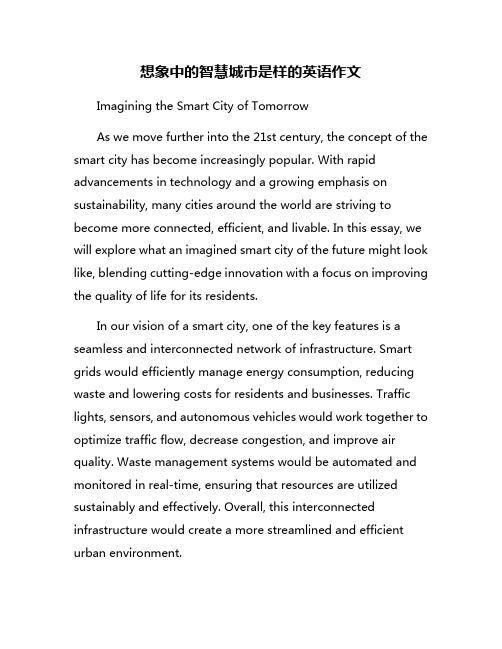
想象中的智慧城市是样的英语作文Imagining the Smart City of TomorrowAs we move further into the 21st century, the concept of the smart city has become increasingly popular. With rapid advancements in technology and a growing emphasis on sustainability, many cities around the world are striving to become more connected, efficient, and livable. In this essay, we will explore what an imagined smart city of the future might look like, blending cutting-edge innovation with a focus on improving the quality of life for its residents.In our vision of a smart city, one of the key features is a seamless and interconnected network of infrastructure. Smart grids would efficiently manage energy consumption, reducing waste and lowering costs for residents and businesses. Traffic lights, sensors, and autonomous vehicles would work together to optimize traffic flow, decrease congestion, and improve air quality. Waste management systems would be automated and monitored in real-time, ensuring that resources are utilized sustainably and effectively. Overall, this interconnected infrastructure would create a more streamlined and efficient urban environment.Another important aspect of a smart city is the use of data and technology to enhance the quality of life for its inhabitants. For example, residents could access real-time information about public transportation schedules, air quality levels, and local events through smart devices and apps. Smart sensors could monitor environmental conditions, alerting city officials to potential hazards and allowing for quick responses to emergencies. Additionally, advanced healthcare technology could enable remote consultations with doctors, personalized treatment plans, and predictive analytics for disease prevention. By leveraging data and technology in these ways, the smart city of the future could greatly improve the well-being and convenience of its residents.In our vision of a smart city, sustainability is a top priority. Green spaces, renewable energy sources, and eco-friendly building materials would be integrated seamlessly into the urban landscape. Parks and gardens would provide a natural respite from the hustle and bustle of city life, while also promoting biodiversity and mitigating the effects of climate change. Solar panels, wind turbines, and other clean energy technologies would power homes and businesses, reducing reliance on fossil fuels and lowering carbon emissions. Recycling programs, composting facilities, and efficient waste management systemswould help to minimize environmental impact and promote a circular economy. By emphasizing sustainability in all aspects of urban planning and design, the smart city of tomorrow would be a model of environmental stewardship and resilience.Moreover, inclusivity and accessibility are core principles of our imagined smart city. In this future urban environment, all residents would have equal access to public services, transportation, and digital infrastructure. Mobility solutions such as bike lanes, sidewalks, and public transit options would be designed with the needs of pedestrians, cyclists, and people with disabilities in mind. Smart technology would be designed to be user-friendly and accessible to people of all ages and backgrounds, bridging the digital divide and empowering communities to participate fully in the digital economy. By prioritizing inclusivity and accessibility, the smart city of the future would be a place where everyone can thrive and contribute to the collective well-being of society.In conclusion, the smart city of tomorrow is an exciting vision of the future that combines innovation, sustainability, inclusivity, and accessibility. By leveraging technology, data, and collaboration, cities can create more connected, efficient, and livable urban environments for their residents. As we continue toevolve and adapt to the challenges of the 21st century, the smart city offers a promising blueprint for a more sustainable and prosperous future. Let us work together to make this vision a reality and build a better world for generations to come.。
中国智慧城市发展的英语作文
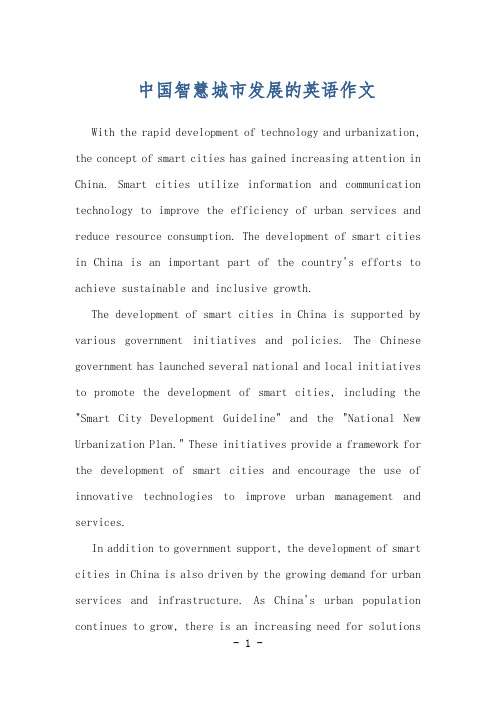
中国智慧城市发展的英语作文With the rapid development of technology and urbanization, the concept of smart cities has gained increasing attention in China. Smart cities utilize information and communication technology to improve the efficiency of urban services and reduce resource consumption. The development of smart cities in China is an important part of the country's efforts to achieve sustainable and inclusive growth.The development of smart cities in China is supported by various government initiatives and policies. The Chinese government has launched several national and local initiatives to promote the development of smart cities, including the "Smart City Development Guideline" and the "National New Urbanization Plan." These initiatives provide a framework for the development of smart cities and encourage the use of innovative technologies to improve urban management and services.In addition to government support, the development of smart cities in China is also driven by the growing demand for urban services and infrastructure. As China's urban population continues to grow, there is an increasing need for solutionsto address urban challenges such as traffic congestion, pollution, and public safety. Smart city technologies, such as intelligent transportation systems, environmental monitoring, and public safety systems, offer innovative solutions to these challenges and have the potential to improve the quality of urban life.Furthermore, the development of smart cities in China is also supported by the country's strong technology industry. China is home to some of the world's leading technology companies, which have the expertise and resources to develop and implement smart city solutions. These companies are actively involved in the development of smart city projects, and their innovative technologies are driving the growth of the smart city market in China.The development of smart cities in China also faces several challenges. One of the key challenges is the integration of different technologies and systems. Smart city projects often involve multiple stakeholders, including government agencies, technology companies, and service providers, and coordinating their efforts can be complex. In addition, there are also challenges related to data privacy and security, as smart city technologies require the collection and analysis of largeamounts of personal and sensitive data.Despite these challenges, the development of smart cities in China presents significant opportunities for economic growth and social development. By leveraging innovative technologies, smart cities have the potential to improve the efficiency of urban services, reduce resource consumption, and enhance the quality of life for urban residents. Furthermore, the development of smart cities can also create new business opportunities and stimulate economic growth in China.In conclusion, the development of smart cities in China is an important part of the country's efforts to achieve sustainable and inclusive growth. With strong government support, a growing demand for urban services and infrastructure, and a thriving technology industry, China is well-positioned to lead the development of smart cities in the future. While there are challenges to overcome, the development of smart cities presents significant opportunities for economic growth and social development in China.随着技术的快速发展和城市化进程,智慧城市的概念在中国越来越受到关注。
